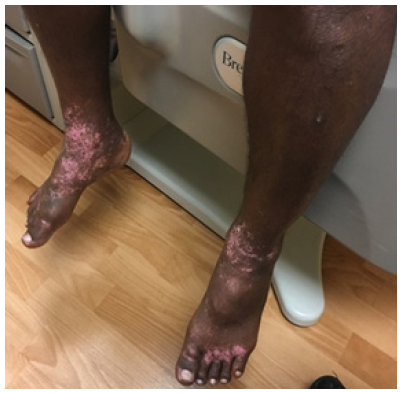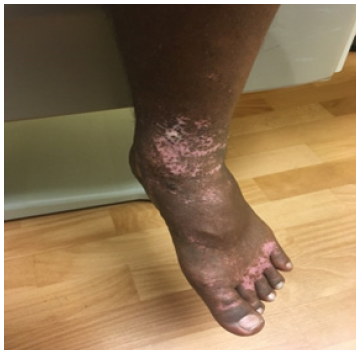Case Report 
 Creative Commons, CC-BY
Creative Commons, CC-BY
POEMS Syndrome Associated with Vitiligo
*Corresponding author:Fabian H Rossi, Department of Neurology Orlando VA Medical Center Professor Neurology UCF Medical School Orlando, USA.
Received: January 22, 2024; Published: February 01, 2024
DOI: 10.34297/AJBSR.2024.21.002841
Abstract
POEMS syndrome is a monoclonal gammopathy associated with polyneuropathy, organomegaly endocrinopathy and skin hyper-pigmentation. We present a 50-year-old patient with POEMS syndrome with vitiligo as its cardinal skin feature. This is the second case of vitiligo reported in a patient with POEMS syndrome, but the first one in an Afro-American patient and localized only in the feet.
Keywords: POEMS, Polyneuropathy, Vitiligo, Skin
Background
POEMS is a multisystem paraneoplastic syndrome caused by underlying plasma cell dyscrasia. POEMS is acronym for P: polyneuropathy, O: organomegaly, E: endocrinopathy, M: Monoclonal Protein (M-protein) and S: skin changes. It is characterized primarily by the polyneuropathy as mandatory major criteria for its diagnosis. Other major criteria include monoclonal plasma cell proliferative disorders, Castleman’s disease [angio-follicular lymph node hyperplasia], sclerotic bone lesions, and elevated Vascular Endothelial Growth Factor (VEGF). Minor criteria, but still helpful in the diagnosis are organomegaly, endocrinopathy, papilledema, thrombosis, and skin changes. The most common skin changes in POEMS by far is hyperpigmentation. We present the first case of vitiligo in an Afro-American patient with POEMS and the second in the literature.
Clinical Presentation
A 50-year-old African American man with a three-year history of numbness that started in the tip of his fingers and over-theyears moved to his toes and ascended to the knees. Simultaneously he developed vitiligo in his feet. He reported symptoms of mild autonomic dysfunction [inappropriate sweating, heat intolerance, and erectile dysfunction] and imbalance associated with several falls. No weakness. Medical history was significant for non-alcoholic idiopathic cirrhosis and hypoparathyroidism. He had no history of diabetes or glucose intolerance. He denied current or prior use of tobacco or recreational drugs. He used alcohol occasionally without overuse. Family history was unknown as he was adopted.
General examination revealed hypopigmentation of his feet. Otherwise, no other skin abnormalities, organomegaly, lymphadenopathy or leg edema. He had no orthostatic hypotension. Neurological examination was remarkable for absent vibratory sensation at the great toes and ankles and decreased at the knees without allodynia. Temperature sensation was absent in both feet. He had reduced tandem gait and positive Romberg sign. There was no papilledema, weakness or atrophy. The remainder of the neurologic examination was unremarkable (Figure 1).
Laboratory was significant for elevated free kappa chain (36.10mg/L [ref 3.30-19.40]), free lambda chain of (26.83 mg/L [ref 5.71-26.30]) and IgA monoclonal band on serum protein electrophoresis. Calcium was (11 mg/dl [ref 8.4-10.6], PTH (7 pg/ ml [ref 14-64]), 24h urine calcium (76 mg [ref 100-250]) and bone alkaline phosphatase (26.6 mcg/l [ref 7-18.3]). Plasma VEGF was elevated (210 pg/ml [ref 31-86 pg/ml]). The highest HgA1C was 5.4. Complete blood count, comprehensive metabolic panel, vitamin B12, ceruloplasmin, TSH, ACTH, random cortisol, vitamin E, celiac panel, RBC-folate, ESR, CRP, Lyme, HIV, phosphorus, magnesium, gamma-GTP, and hepatitis C were normal.

Figure 1A: Patient with hypopigmented macules in bilateral lower extremities (vitiligo) Figure 1A: Vitiligo in both feet.
Ultrasound of the liver showed mild enlargement; coarse, lobulated, heterogeneous contour nodularity suggestive of cirrhosis with findings of portal hypertension and mild ascites. Brain MRI and bone marrow scan were unremarkable. A year later bone marrow remained unremarkable. Chest CT showed no suspicious adenopathy, pulmonary consolidations or cardiomegaly. Mild coronary artery calcifications were present. X-rays of the hand, elbow, shoulder, and knees demonstrated non-sclerotic lytic lesions. Nerve conduction studies showed a sensorimotor axonal polyneuropathy. Based on the combination of polyneuropathy, monoclonal gammopathy, organomegaly, endocrinopathy and elevated VEGF the diagnosis of POEMS was made. Autologous stem cell transplantation was recommended, but declined by patient. No other therapy was initiated in the absence of pain. He remains stable over five years. Vitiligo did not change in characteristics and did not propagate to other parts of his body. Repeated VEGF decreased to <31pg/ml three years later.
Discussion
POEMS is a multisystem paraneoplastic syndrome with the core features of polyneuropathy and plasma cell proliferative disorder, associated with cirrhosis with ascites, hypoparathyroidism, elevation of plasma VEGF and skin changes [1,2]. Skin changes are seen in 50-90% of patients with POEMS, most commonly hyperpigmentation [3,4]. Other skin abnormalities reported in POEMS are hemangiomata, hypertrichosis, vascular skin changes (Raynaud’s syndrome, rubor, acrocyanosis, hyperemia/erythema, flushing and plethora), skin thickening, nails changes with white nails and clubbing and pruritus [3-9]. Facial atrophy was also reported [10]. This is the first case of vitiligo reported in Afro- American patient and affecting only his feet. There is one prior case in English described in a 46-year-old black Pakistani male with POEMS and vitiligo affecting his face, arms, back and trunk, but not his feet like in this case. Remarkably, treatment with autologous hematopoietic stem cell transplant resolved his vitiligo [8]. Our patient chose a conservative approach, but his vitiligo did not change in characteristics and did not spread to other part of the body over a six-year follow-up period.
Conclusion
POEMS syndrome should be suspected in any patient with new onset of vitiligo in the presence of an underlying polyneuropathy and a monoclonal plasma cell proliferative disorder
Study Funding
No targeted funding reported
Disclosures
The authors report no disclosures relevant to the manuscript.
Acknowledgements
None.
Conflicts of Interest
None.
References
- Misawa S Kuwabara S (2013) Polyneuropathy, organomegaly, endocrinopathy, monoclonal gammopathy, and skin changes (Crow-Fukase) syndrome: diagnostic criteria and treatment perspectives. Clin. Exp. Neuroimmunol.
- Dispenzieri A (2017) POEMS syndrome: 2017 Update on diagnosis, risk stratification, and management. Am J Hematol 92 (8): 814-829.
- Luigetti M, Conte A, Bisogni G, Del Grande A, Sabatelli M (2015) 'White nails'. Skin changes in POEMS syndrome. Eur Neurol 73 (1-2): 89-112.
- Dispenzieri A, Gertz MA (2005) POEMS syndrome. Orphanet.
- Brazis PW, Liesegang TJ, Bolling JP (1990) When do optic edema and peripheral neuropathy constitute poetry? Surv Ophthalmol 35(3): 219-225.
- Dispenzieri A, Kyle RA, Lacy MQ, S Vincent Rajkumar, Terry M Therneau, et al. (2003) POEMS syndrome: definitions and long term outcome. Blood 101(7): 2496-2506.
- T Nakanishi, I Sobue, Y Toyokura, H Nishitani, Y Kuroiwa, et al. (1984) The Crow-Fukase syndrome, a study of 102 cases in Japan. Neurology. 34(6): 712-720.
- Takasuki K, Sanada I (1983) Plasma cell dyscrasia with polyneuropathy and endocrine disorder: clinical and laboratory features of 109 reported cases. Jpn J Clin Oncol 13(3): 543-555.
- Ji ZF, Zhang DY, Weng SQ, Shen XZ, Liu HY, et al. (2012) POEMS syndrome: a report of 14 cases and review of literature. ISRN gastroenterol 2012: 584287.
- Bachmeyer C (2012) Acquired facial atrophy: a neglected clinical sign of POEMS syndrome. Am J Hematol 87(1): 131.





 We use cookies to ensure you get the best experience on our website.
We use cookies to ensure you get the best experience on our website.